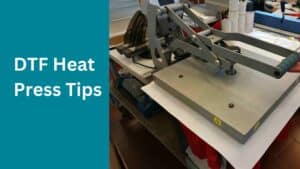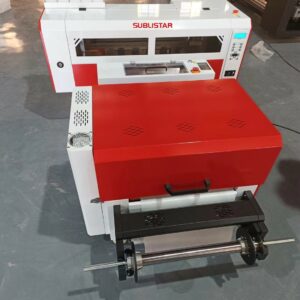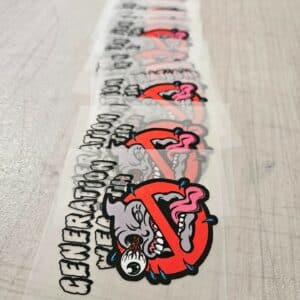Do you want to learn how to use a heat press to print DTF?
The heat press is a crucial step in the DTF printing process because it produces prints that are high-quality and durable. Without correct directions, it might be difficult to accomplish the intended outcomes.
This is where this blog comes in; we’ll show you how to use a DTF heat press specifically so that you can consistently produce beautiful and colorful graphics.
Join us as we explore some important DTF heat press instructions and create beautiful patterns on various materials. Let’s get going!

How to Heat Press DTF transfers?
Preparing for Heat Pressing
Gather materials specific to DTF printing
Before utilizing a DTF heat press, make sure you have all the materials:
- DTF printer
- DTF transfer paper
- DTF adhesive powder
- Fabric or garment to be printed on
- Scissors or cutting tool
- Masking tape
- Heat-resistant gloves
Having all of these items will make DTF printing go well.
Set up DTF heat press
Next, set up the DTF heat press. First, check sure the press is plugged in and steady. Verify that the time and temperature controls are operating properly.
Power on DTF heat press:

Activate the DTF heat press and allow it to reach the desired temperature. Depending on the kind of transfer paper, cloth, and adhesive powder you are using, the optimal temperature for DTF printing may change. To find out the ideal DTF heat press temperature setting, it’s crucial to refer to the directions for each unique product.
Setting the temperature for DTF printing:
The heat press should be 320-360°F (160-180°C) for DTF printing. To prevent any harm to the transfer paper or cloth, it is crucial to ensure that the temperature is exact.
DTF printing time settings:
For DTF printing, the time setting is just as important as the temperature. The suggested duration is often between 15 and 40 seconds. (it depends on the type of garment or material).
Pressure settings for DTF printing:
Lastly, it’s crucial to change the DTF heat press’s pressure settings. Without inflicting any harm or discoloration, the pressure has to be sufficient to transfer the pattern onto the cloth. Prior to beginning the printing process, it is crucial to verify the pressure setting on a tiny piece of cloth.
Procolored Heat Press Machine For DTF Printer
- Dual display control box
- Maximum power of the machine: 1800W
- Heat transfer heating plate area: 38×38CM
- Machine box gauge: 52*46*51CM
Slendor 5 in 1 Heat Press Machine
- Shirt Press 12×15 inch
- Fully-assembled machine with platen press
- Plate Press
- Hat Press
- Mug Press
VEVOR Heat Press Machine – 8 in 1
- Heat-up Fast & Evenly
- 8 in 1 Heat Press – Wide Application
- 360° Swing Away Design
- Large Heat Plate
HTVRONT Auto Heat Press Machine for T Shirts
- Auto Press & Free Hands
- Heat-up Fast & Evenly
- Safety Use & Auto-Off
- Wide Application & Great Service
15“x15″ High Pressure Heat Press Machine
- Automatic Floatation Feature
- After-sale Protection
- Upgraded Time/Temperature Gauge
- Secondary Bottom Board Handle
Preparing the Material
Pre-wash the fabric:
Pre-washing the cloth is necessary before printing in order to get rid of any sizing, oil, or dirt that can interfere with the transfer process. The cloth should be dried on low heat after being washed in cold water without fabric softener. It is essential to avoid using chlorine and abrasive detergents that could damage the fabric.
Cut transfer paper to size:
Use scissors or a cutting instrument to cut the DTF transfer paper to size. It’s important to make sure the transfer paper is cut to the right size, as this will keep any extra glue powder from sticking to the fabric.
Apply adhesive powder to transfer paper:
Apply a uniform, fine coating of DTF adhesive powder on the transfer paper using a powder shaker. Applying too much powder might degrade the quality of the final print, so take care not to do so.
Shake off excess adhesive powder:
Shake off any extra adhesive powder from the transfer paper after applying it. This step is essential for ensuring that just the right quantity of powder sticks to the transfer paper and that no extra powder transfers to the cloth.
Apply transfer paper to fabric:
When the transfer paper is prepared, gently place it where you want it on the cloth. Make sure the transfer paper is smooth and free of creases and bubbles by taping it to the cloth using masking tape.
Get ready to heat press:
To protect both the transfer paper and the heat press, it is crucial to cover it with a piece of heat-resistant paper before heat pressing. To prevent creases or uneven pressure, make sure the heat-resistant paper is the same size as the transfer paper and the cloth.
Heat Pressing the Design

Place fabric onto heat press:
Place the cloth and transfer paper carefully on the heat press. Ensure that the fabric is wrinkle- and bubble-free and level.
Adjust pressure and time settings:
Adjust the heat press pressure and time according to the transfer paper and fabric directions before pressing. To get the finest results, it’s crucial to make sure the pressure and time settings are correct.
Cover transfer paper with heat-resistant paper:
Heat-resistant paper protects the transfer paper and heat press.
Press transfer paper onto fabric:
Press the transfer paper onto the fabric by closing the heat press. But how long to press DTF transfers? Hold it there for the recommended amount of time, usually 30 to 40 seconds.
Open heat press and remove transfer paper:
Carefully remove the heat-resistant paper and transfer paper from the heat press once the time is up. To achieve a crisp and colorful design, remove the transfer paper when hot.
Allow fabric to cool:

Before touching the cloth after removing the transfer paper, let it cool fully. By doing so, the pattern is thoroughly transferred to the cloth and is protected from smearing or other damage.
Post-Pressing
Peel off excess adhesive powder:
There can be extra adhesive powder on the cloth after heat pressing the transfer paper on it. Simply use a lint roller or brush to take off the extra powder to eliminate this. To prevent ruining the pattern, be careful to do this lightly.
Fix the layout:
It’s crucial to cure the design to make sure it is robust and long-lasting. For a further 30 to 40 seconds, place the cloth in a heat press and apply heat and pressure. In order to prevent the pattern from pealing or fading over time, this step helps to set it.
Wash the fabric:
After the pattern cures, wash the cloth. To avoid any pattern damage, you must strictly adhere to the washing directions for both the fabric and the transfer paper. Wash the cloth in cool water without bleach or strong chemicals.
Dry the fabric:
After washing, either let the cloth dry naturally or put it in a dryer on a low heat setting. Avoid excessive heat settings to protect the design.
Iron the fabric:
It’s a good idea to iron the cloth on a low heat setting once it has dried to get rid of any wrinkles or creases. Remember to avoid ironing directly on the pattern to prevent peeling or fading.
Additional Heat Press Settings for DTF
It is essential that you adhere to the suggested care procedures to preserve the quality and duration of your transfer:
- Avoid applying intense heat to the transfer, such as when ironing or using a hot dryer.
- To stop the transfer from fading or breaking, wash the item in cold water.
- Tumble dry the garment on low heat or hang it up to air dry.
- To avoid creases, take the item out of the dryer right away and fold it or hang it up.
- Do not iron the transfer, as this can damage the design.
The transfer should feel more comfortable over time since DTF transfers often become softer with each wash. - A second press with Teflon or parchment paper is required to get the ideal soft appearance and feel. Bypassing this stage, you risk getting a texture or look you don’t like.
Conclusion- DTF Heat Press Instructions
Heat pressing DTF transfer paper onto cloth is a great technique to make beautiful, durable patterns. By adhering to the steps indicated in this manual, you can ensure that your design appears fantastic and retains its color wash after wash.
It’s important to remember to properly prepare your materials, set up your heat press, and do the steps after pressing to make sure your design is finished, washed, and dried correctly. You’ll be able to produce stunning designs with the DTF heat press instructions in mind and they’ll last for years.
FAQs
It is not suggested to use an iron for heat pressing DTF transfers since it may not generate adequate pressure or continuous heat for an effective transfer. The ideal instrument for DTF transfers is a heat press because it enables exact temperature and pressure control for a high-quality transfer outcome.
Yes, in order to transfer the pattern onto the cloth most effectively and efficiently, a heat press is required for DTF transfers.
No, DTF transfer paper is only intended for a single usage. After being heat pressed into the cloth, the transfer paper cannot be reused.
Yes, you can. Layering DTF transfer paper patterns creates unique, intricate designs. But it’s important to think about how thick the transfer paper is and change the heat press settings properly to avoid burning and ruining the design.
No, DTF transfer paper is not compatible with sublimation printers. DTF transfer paper needs a certain kind of ink made for the adhesive layer that is present on the transfer paper.
You can heat-press a variety of textiles, including cotton, polyester, mixes, and even certain kinds of nylon using DTF technology. It’s crucial to choose the proper transfer paper and modify the heat press’s settings to correspond with the chosen cloth.

Ashley Wang is a skilled sales manager with knowledge in DTF printing. She presently works for ShenLan Digital, a reputable DTF printer maker. Ashley is the best person to offer advice on selecting the most suitable DTF printer because she has tested a lot of them. She launched DTFPrinterSchool to educate individuals and organizations about DTF printing technology, providing her expertise and observations on the most recent advancements in the sector. Ashley is an invaluable resource for businesses and individuals wishing to invest in DTF printing technology because of her expertise and experience in the industry.





